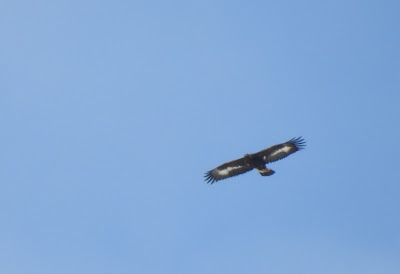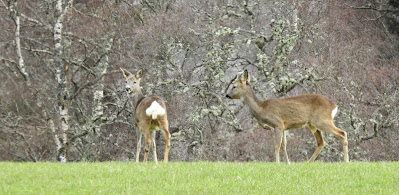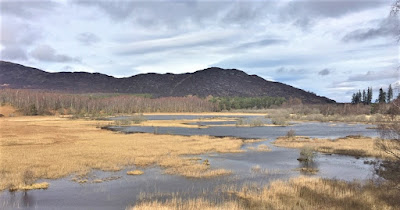March 2023
March 2023 started with a cold and wintry feel, but the remainder of the month saw our weather largely dominated by low pressure systems from the west, and occasionally the north, with just the odd high pressure day, meaning it was very changeable with just about every type of weather experienced at some stage, and sometimes even in the same day!
It should be noted that temperatures can vary from -6c to +16c in the same day at this time of year!, so I would recommend bringing a good variety of clothing if you are planning a future March visit as the weather can be very unpredictable.
The milder days and occasional sun really got the birds active, and it was great to hear the ever-increasing dawn chorus, with lots more bird species heard singing for the first time this year , Woodpeckers drumming, Snowdrops and Crocuses in flower, the first Frogs and Toads emerging, and a few more brave insects on the wing, ...welcome signs that winter is turning into spring...
The days are really lengthening noticeably now, with up to 12 hours of usable daylight, and dawn (for the Black Grouse) is still a relatively sociable 6 am, with dusk at around 7 pm.
I was away visiting relatives for the second week of the month, so my report may be a little shorter than usual, and may include some photos from previous March's for illustration of 'typical sighting' purposes....
 |
| Late winter at a picturesque local loch |
To give you an idea of what you may realistically hope to see if you are considering a future March visit, I hope the following more detailed information, illustrated with photos taken at sites in and around the Cairngorms National Park, and sometimes further afield, by myself, my friends or my safari clients this month and in previous March's will help....clicking on the picture enlarges it to full-screen.
Local speciality/upland bird species seen regularly during the month included:
Black Grouse (dawn or soon after only) , Red Grouse, Dipper, and Goldeneye, we also had several decent views of soaring Golden Eagle and White-Tailed Eagle, and a few brief sightings of Crossbills, and Crested Tits, and from the third week, our first local views this year of Red-Throated Diver and Black-Throated Diver - both coming into their splendid summer breeding plumage - and at the very end of the month, our first Ospreys, Slavonian Grebes and Ring Ouzels joined the ever-increasing numbers of other Summer visiting birds , such as Lapwing, Oystercatcher and Curlew.
Sadly though, my 'year-tick' Capercaillie sighting still escapes me, despite my best efforts....
Mammal species seen regularly included:
Red Deer, Roe Deer, Rabbit, Brown Hare, Mountain Hare (still mostly white), Red Squirrel, and Feral Mountain Goat (with young), with just one glimpse of a white Stoat on the 6th, whilst two Otters were seen feeding in the sea near Inverness on the 16th, and both types of Seal were seen at the nearby Moray coast.
March 2023 bird sightings in more detail:
Up on the moors....
 |
| A local upland heather moorland |
 |
| Lekking Black Grouse (photo from March 2022) |
 |
| Lekking Black Grouse (photo from March 2021) |
Black Grouse are not an easy species to see in most of the UK now, having suffered an 80% decline in numbers over the last 20 years, with their range contracting northwards. They are birds of remote upland moors, preferably with forests and a grassy 'lekking' patch nearby, a very specific combination of habitats that is not so common nowadays. Fortunately, the Scottish Highlands still has a decent number of active 'lek' sites, where the cock birds gather to 'strut their stuff', and dawn (about 6 am in March) on my safaris in the first five months of the year is usually spent enjoying this memorable experience. 'Performances' were noticeably better on calm, frosty mornings.... but please be aware that to avoid disturbance, we have to view from a respectful (and legal) distance, that sightings are not guaranteed, and the birds can fail to show , sometimes without any obvious reason, or if disturbed by a predator or wandering sheep, cattle , horses.... or inconsiderate birders/photographers......
 |
| Female Red Grouse (photo from March 2022) |
 |
| Male and female Red Grouse |
Still on the upland heather moorlands, many of our our local Red Grouse have most definitely already paired-up, and the cock birds, with red 'eyebrows' aglow, now seem to be concentrating more on defending their territory and partner from rival birds, often posturing aggressively from the higher parts of the moor whilst cackling loudly, and occasionally flying aggressively at encroaching competitors....
Up in the glens...
 |
| Late winter in a local upland glen |
 |
| Golden Eagle by Steve Nicklin (photo from March 2018) |
 |
| White-Tailed Eagle (photo from March 2021) |
As I have mentioned many times before, the shorter days of the winter months (Oct-Feb) give us our best chance of seeing Golden Eagles and White-Tailed Eagles, as when the days lengthen and breeding season commences, the frequency of sightings definitely reduces, but despite the adult females presumably preoccupied by nesting by now, we were still fortunate enough to enjoy a few decent sightings of these majestic birds hunting in my favourite upland glens.
 |
| Peregrine Falcon (photo from March 2017) |
 |
| Common Buzzard (photo from March 2022) |
In the forests...
 |
| Ancient Caledonian forest |
 |
| Crested Tit by Jan Shields (photo from march 2020) |
Crested Tits were occasionally seen at and around my favourite feeding stations , at least early in the month anyway, but sadly, as the month progressed, they often failed to show and when they did, they didn't stay for long and rarely called, suggesting perhaps, that they are now concentrating on breeding rather than feeding.....but if you can familiarise yourself with their distinctive calls and song, you always have a chance of seeing them whilst walking in suitable habitat....
It is well worth noting that the colder winter months (October-Feb) are actually the best time of year for seeing the 'wee Cresties', as these characterful little birds can be frustratingly secretive, unobtrusive and almost silent during the breeding season, with sightings being much more difficult to obtain between March and September....
Please note that Capercaillie numbers would still appear to be declining alarmingly, and I would only rate our chances of seeing one my safaris as "very slim" at best, and now we are into 'lekking' season, I will be 'responsible' by staying out of 'sensitive' areas at dawn through April and May to allow this now very rare and elusive bird to (hopefully) lek and breed in peace....
On the lochs...
 |
| A picturesque local loch |
 |
| Slavonian (Horned) Grebe (photo from late March 2017) |
 |
| Red-Throated Diver (photo from late March 2019) |
 |
| Black-Throated Diver (photo from late March 2022) |
Towards the end of March, it is always great to see the return inland (they winter on the sea around the coast of the UK) of some of our rarest and in my opinion, most beautiful local speciality birds, namely Red-Throated Diver, Black-Throated Diver and Slavonian Grebe.
Scotland is at the south-westerly edge of the world-wide breeding range for these very sought-after species, and the only place in the UK to see them in summer plumage, and I am always very happy (and relieved) to see them back on their favoured waters....
On the rivers...
 |
| A local stretch of the River Spey |
 |
| Dipper |
 |
| Dippers by Steve Nicklin (photo from March 2020) |
Dippers were seen frequently on local rivers this month, and they seemed to have procreation on their minds, as I am now (presumably) only seeing male birds, and late in the month they appeared to be delivering nesting material to their mates, and defending territory near their favourite nest sites of old bridges....
 |
| Male Goosander |
We also saw Goosanders reasonably frequently on local rivers this month too...
On farmland....
 |
| Typical local farmland |
 |
| Oystercatchers |
 |
| Lapwing |
Lots of waders were seen returning to their spring/summer breeding grounds, with increasing numbers of Oystercatcher, Lapwing, Golden Plover, Curlew and a few Redshanks all being noted.....
Up in the mountains....
 |
| The Cairngorm Mountains in late winter |
 |
| Snow Bunting |
Snow Buntings can often be seen in and around the Cairngorms Ski Centre car park in winter time, and that was the case on a few occasions this month, with up to 6 of these attractive and characterful little birds being seen. Their confiding nature means that you can sometimes creep reasonably close for photos too, especially if you put some wild bird seed out to attract and distract them....Though it should be noted that, as soon as the snowline recedes higher up the mountain , as it did from mid month, the birds usually stop visiting the car park area....
I didn't venture up into the mountain-tops myself this month, but for future reference, a few Ptarmigan , still totally white, can sometimes be seen, up around the 'snow-line', usually sheltering in corries or on the leeward sides of ridges, out of the cold wind...
Winter-visiting birds seen in our area this month included:
 |
| Fieldfare |
 |
| Whooper Swans |
 |
| Waxwing |
Whooper Swans, Grey Geese (Greylag , Pink-Footed and a few Barnacle), Redwings, Fieldfares, Redpolls, a few elusive Bramblings, and just one Waxwing...please be aware though, that these are all likely to depart this area soon....
Other good/scarce birds seen/reported locally this month included:
A couple of Ring-Necked Ducks on local lochs, and a Nuthatch in the Insh area....
A few photos of more common birds seen locally this month:
 |
| Canada Geese |
 |
| Wood Pigeon |
 |
| Male Blackbird |
 |
| Yellowhammer |
Adventures 'out of area': The Moray Coast.
 |
| The Moray Coast |
 |
| Pink-Footed Geese |
 |
| Curlew |
 |
| Purple Sandpipers |
 |
| Male Long-Tailed Duck |
 |
| Male Eider |
 |
| Male Wigeon |
The Moray coast is only about an hour drive north of Aviemore, and trips to favourite reserves, lochs, bays and harbours gave good views of wintering birds such as Greylag Geese, Pink-Footed Geese, Whooper Swan, Shoveler, Wigeon, Teal, Pintail, Black-Tailed Godwit, Bar-Tailed Godwit, Knot, Golden Plover , Grey Plover , Ringed Plover, Purple Sandpiper, Redshank, Oystercatcher, Turnstone, Curlew, Common Scoter, Velvet Scoter, Long-Tailed Ducks, Eiders, Divers, and Slavonian Grebe, with the chance of scarce birds such as Tree Sparrow and Grey Partridge, and rare gulls.....
March 2023 mammal sightings in more detail:
 |
| Mountain Hare |
March is the last month to see our local Mountain Hares in their beautiful all-white winter coats, though a few are usually starting to morph into their spring blue/grey colours by now, and a few may have grey-brown faces, but they still usually get voted as 'mammal of the day', with many of my safari clients delighted to see them, often for the first time, and if their upland habitats remain relatively snow-free , they can actually be reasonably easy for me to find, and can often be quite confiding, occasionally allowing a reasonably close approach for photography....
It should be noted though, that most of our views are at long range through my telescope, and that a closer view usually involves some considerable amount of rough uphill walking, often on snow.
 |
| Red Deer stags (photo from March 2020) |
Red Deer are obviously an iconic Highlands animal, often featuring on the wish-list of my safari clients, and visits to suitable upland areas usually result in us getting to see them, often in large same-sex herds, though again, it should be noted, that most of our views are from a fair distance and that many of the stags have now shed their old antlers, and are growing new sets, and are therefore not quite as impressive as they look in autumn and winter.
Red Squirrels are pretty reliable visitors to the quieter forest feeding stations, especially during the colder weather, and we saw them regularly on our adventures this month, and we also had some nice random sightings on our drives and walks through local forests...
 |
| Roe Deer |
Roe Deer, despite being common and widespread throughout the UK, due to their crepuscular nature and slightly nervous disposition, can actually be surprisingly difficult to see. However, if you are out and about early or late in the day in suitably quiet areas, you always have a chance...
 |
| Junior Hairy Highland Coos |
 |
| Carrot time for Murdo The Magnificent means big smiles all round |
Hairy Highland Coo's always prove to be popular with my safari clients, especially those who do not have them close to home, so don't be afraid to ask me if you fancy going to see them, and maybe even get to feed and 'pat' them, as I have a couple of great sites....
Rare/nocturnal mammals:
I get a few enquiries about the possibility of seeing Badgers and Pine Marten from my safari clients, many of whom I suspect are unaware that they are actually a largely nocturnal creature, and although we do get the occasional (maybe one or two a year) dawn glimpse of one, you would definitely have a much higher chance of seeing them at a specific dusk Badger/Pine Marten watching hide - Please contact me for more information.
Similarly, our inland Otters too are mainly active during the hours of darkness, and again, although we do get a few early-morning sightings on local lochs and rivers each year, looking for them feeding in a suitably quiet, kelp - filled bay on the coast on a rising tide, but at any time of day, would give you a much better chance.
Whilst we are still on the 'tricky to see stuff', the Scottish Wildcat too, as well as being incredibly rare now, is also generally nocturnal, and the fact that I have had a mere handful of (dawn or dusk) sightings in 17 years of providing wildlife safaris should give you an idea of how difficult they are to see.
Other wildlife:
 |
| Common Toad |
The first Frogs and Toads were seen out and about this month, and even a few brave insects were seen out on the wing for the first time this year....
News:
All tourism/hospitality/activities in Scotland are open , are free of restrictions and I have now completed well over a year and a half of (thankfully!) increasingly busy and extremely enjoyable safaris with clients with no major issues arising.
With all national travel restrictions lifted too, Scotland is officially 'open for business' for visitors from all over the UK, and from abroad.
For those considering a visit, these wildlife/outdoor tourism websites may prove useful:
https://www.gov.scot/collections/coronavirus-covid
NatureScot (outdooraccess-scotland.scot)
Can Nature Help Health? | Nature Prescriptions - YouTube
Scotland, Yours to Enjoy. Responsibly. - YouTube
Cairngorms National Park Authority
Positive prescriptions | The RSPB
 |
| Snowdrops |
COVID-19
The Scottish Highlands, being very sparsely populated, has had very few COVID-19 cases in comparison to most of the UK, and on my safaris we tend to visit remote , wild habitats well away from the more popular tourist areas, and usually have very little interaction with other people, and this is something that I intend to continue.
 |
| A local marshland |
Summary:
Although March can be a bit of a 'transitional' month, with winter slowly turning to spring, and the weather often a bit changeable, looking back through my sightings log and photos, I reckon that we did pretty well for birds and mammals this month. Most of the 'winter specialities' continued to show reasonably well, if admittedly not as frequently as last month, the resident species generally cooperated pretty well, and we enjoyed the return of a few summer breeding birds towards the end of the month too.
I certainly enjoyed my times out in the wilds this month, and most importantly, I think my safari clients did too, and with lots of them visiting this area for the first time, it was great to see them smiling, and hear the sharp intakes of breath and the "wows" when they saw something rare, exciting or new to them..
Reviews:
https://www.tripadvisor.co.uk/Attraction_Review-g186537-d3335134-Reviews-
 |
| An early morning walk in a Caledonian forest |
Gift Certificates:
 |
| Safari gift voucher |













%209.JPG)

